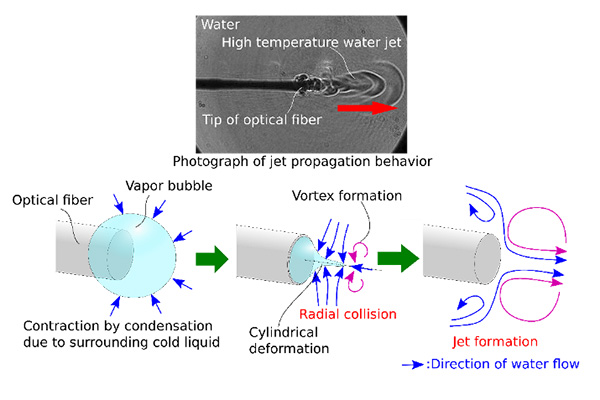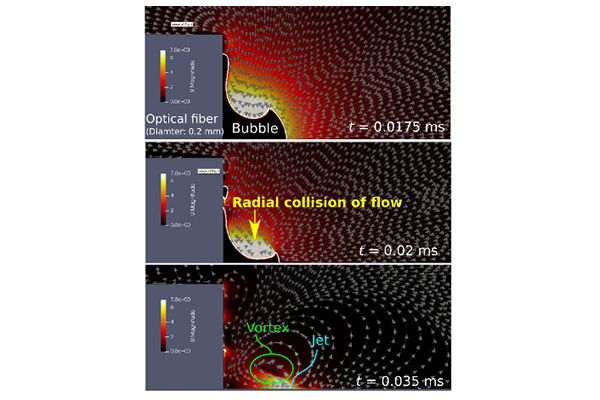When an optical fiber is immersed in liquid, a high temperature, high speed jet is discharged. Researchers expect this to be applied to medical treatment in the future. Now, a research team from Russia and Japan has explored this phenomenon further and revealed the reasons behind the jet formation.
Lasers using a thin optical fiber and combined with an endoscope and catheter can be easily transported into deep areas of the body or inside blood vessels. Traditionally, affected areas or lesions are removed by generating heat inside the tissue through laser absorption - a process known as the photothermal effect.
Yet, hydrodynamical phenomena, such as microbubble formation or high-speed jet generation from the optical fiber, show immense medical promise.
The process of jet formation happens when the laser is irradiated to the water, causing the water to boil and a vapor bubble to form at the tip of the optical fiber. The vapor bubble grows until the laser energy absorbed in the liquid is consumed. Because of the surrounding cold liquid, condensation suddenly shrinks the vapor bubble.

The observation of water jets in experiments and the schematics of the jet formation mechanism. ⒸJunnosuke Okajima, Tohoku University
Using a numerical simulation, Dr. Junosuke Okajima from Tohoku University's Institute of Fluid Science, along with his colleagues in Russia, set out to clarify the jet formation mechanism. Their simulation investigated the relationship between the bubble deformation and the induced flow field.
When the bubble shrinks, the flow toward the tip of the optical fiber is formed. The flow deforms the bubble into the cylindrical shape. This deformation induces the collision of flow in a radial direction. This collision generates the jet forward. As a result of collision and jet formation, the vortex - seen in Fig.1 - is formed at the tip of the deformed bubble and it grows larger.

The numerical simulation results of bubble deformation at the tip of optical fiber and the induced flow field. ⒸRoman Fursenko
"We found the jet velocity depends on the relationship between the size of the vapor bubble just before the shrinking and the fiber radius," said Okajima. "We will continue to develop this study and try to find the optimum condition which maximizes the jet velocity and temperature, making further laser surgical techniques more effective and safer."
The project was part of the Russian Federation's Ministry of Science and Higher Education's Megagrant project, where Okajima serves as the leading scientist. For the current publication, he collaborated with Dr Roman Fursenko of the Siberian Branch of the Russian Academy of Sciences, professor Vladimir Chudnovskii, professor Sergey Minaev, and professor Mikhail Guzev, all from the Far Eastern Branch of the Russian Academy of Sciences.
- Publication Details:
Title: Mechanism of high velocity jet formation after a gas bubble collapse near the micro fiber immersed in a liquid
Authors: Roman V. Fursenko, Vladimir M. Chudnovskii, Sergey S. Minaev, Junnosuke Okajima
Journal: International Journal of Heat and Mass Transfer
DOI: 10.1016/j.ijheatmasstransfer.2020.120420
Contact:
Junnosuke Okajima
Institute of Fluid Science, Thohoku University
Institute of Applied Mathematics, Far Eastern Branch of the Russian Academy of Sciences
Email: j.okajima tohoku.ac.jp
tohoku.ac.jp
Website: http://www.ifs.tohoku.ac.jp/eng/index.html

